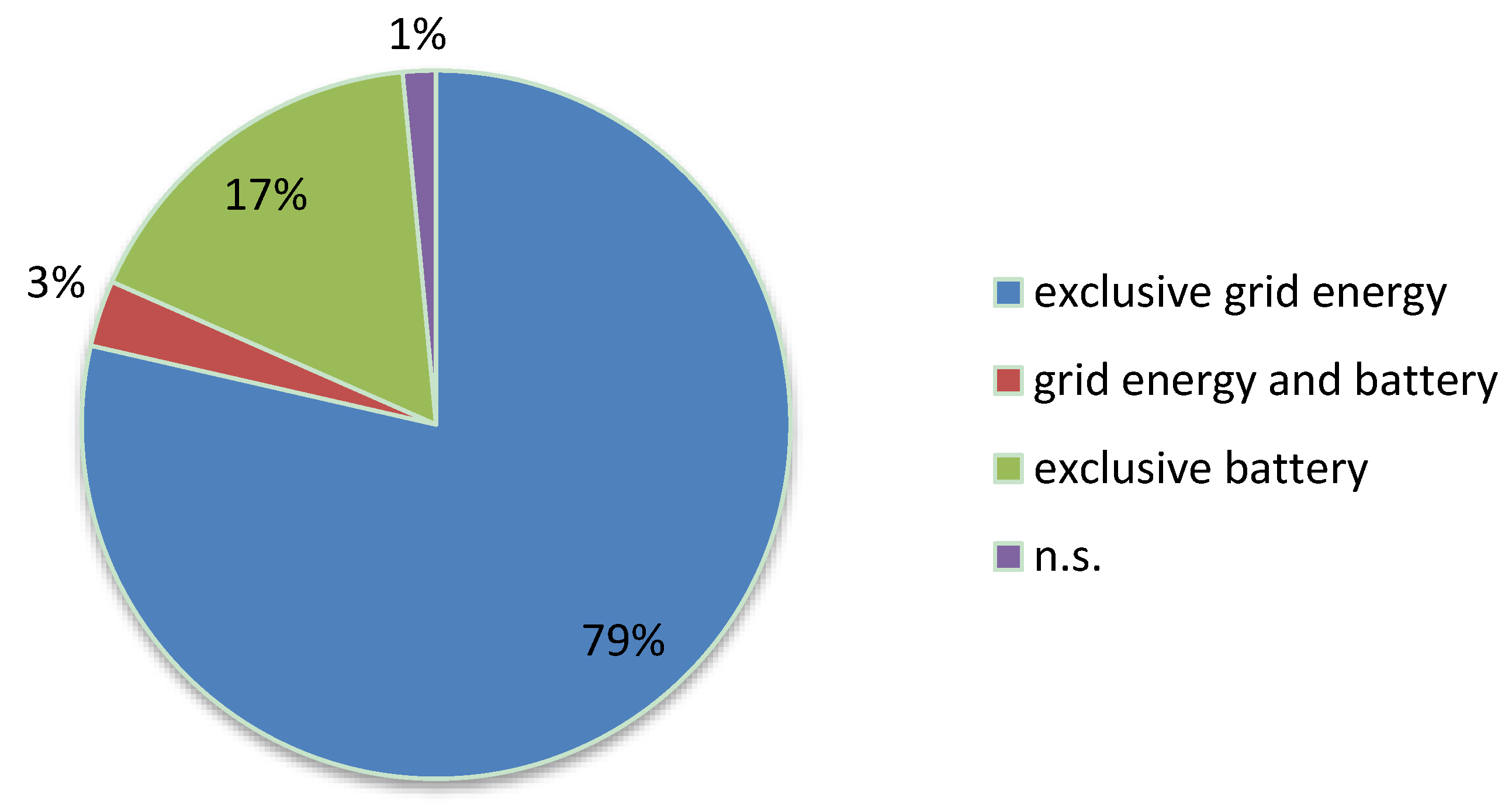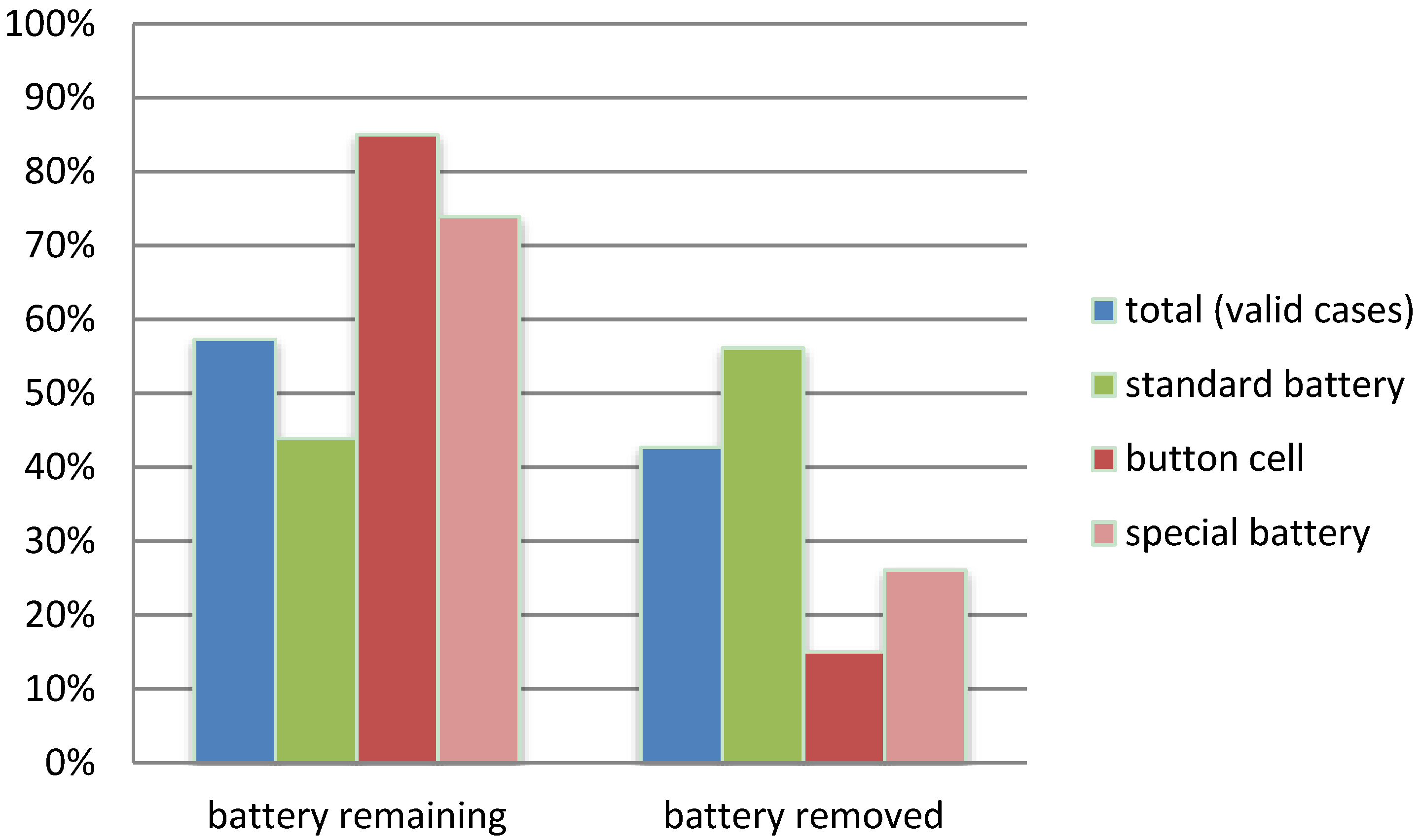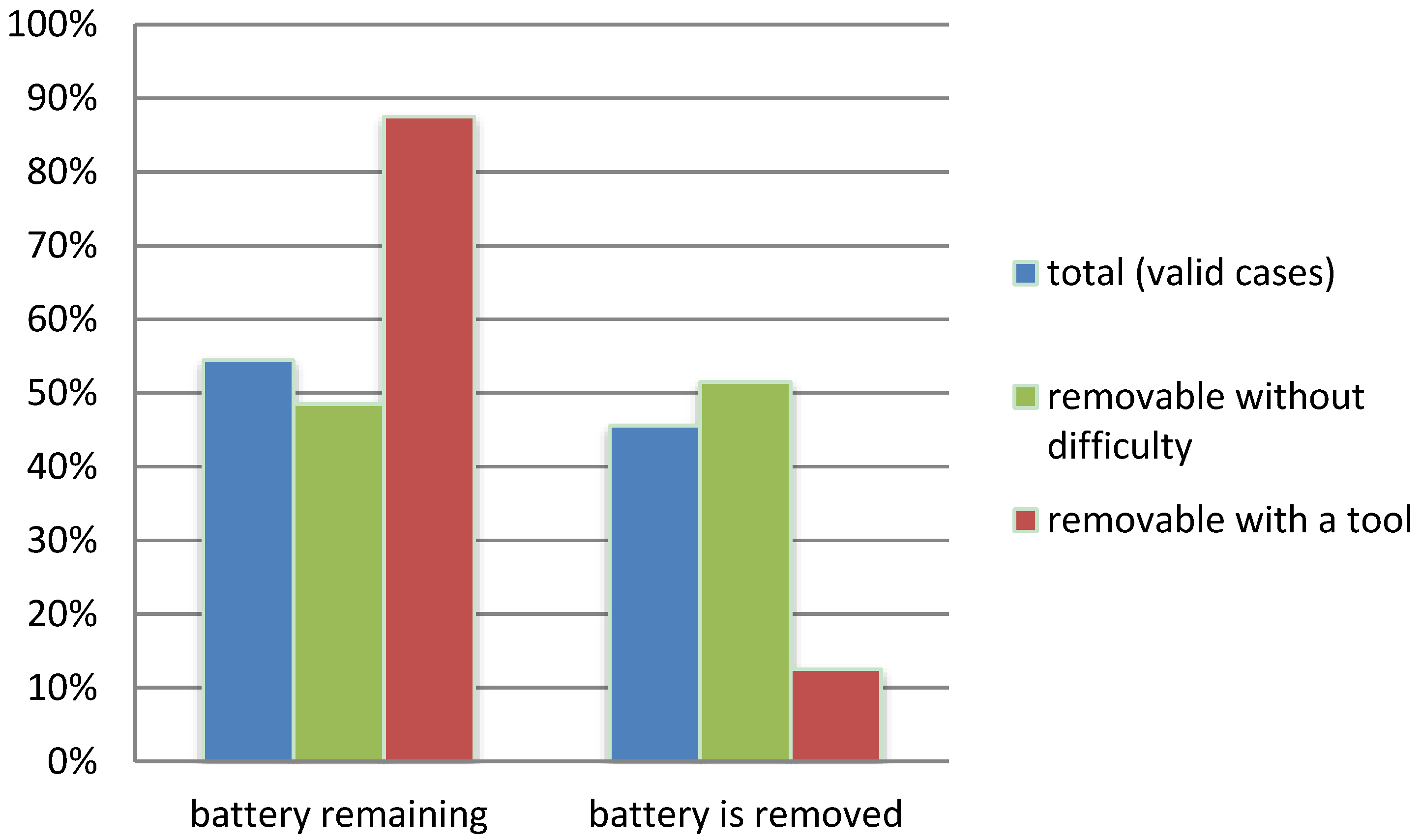1. Introduction and Aim of the Study
WEEE is the fraction of waste experiencing the greatest growth rate worldwide [
1,
2]. Batteries (i.e., primary cells which cannot be recharged) and accumulators (i.e., secondary cells for recharge) are used in many electric and electronic appliances, such as personal computers, mobile phones, tools, and toys. In what follows, primary and secondary electric cells are referred to as “batteries”. The number of battery-driven electric devices is growing very rapidly due to the availability of high-energy batteries, which are mostly based on Li ions and provide a far higher charge density compared with conventional batteries based on Pb or Ni/Cd. The volume of rechargeable Li ion batteries on the European market increased twelvefold between 2001 and 2012 [
3]. These batteries have become an integral component of electric and electronic devices. They can either be replaced by the user or are permanently installed in the device (i.e., mobile phones). According to a recent study on the Swedish market [
4], the number of accumulators used in electric and electronic products increased by about 500% between 1996 and 2012. Moreover, the weight of batteries integrated in electric appliances is now increasing even faster due to the use of large Li ion batteries for motorcycles, garden tools, etc., which in the past were not equipped with accumulators. The weight share of batteries in small electric and electronic appliances is between 8% ± 5% (radio sets) and 35% ± 3% (cell phones) [
5]. By contrast to conventional batteries, Li batteries are based on organic electrolytes instead of aqueous solvents. Damaged Li batteries are particularly critical as they can ignite in the case of a short circuit. Li batteries are therefore subject to strict transport regulations, depending on the weight of the overall freight unit, the battery’s individual weight, and its condition, i.e., damaged or undamaged.
The European regulation on WEEE was amended in 2012 and is now being implemented by the Member States (MS’s). The WEEE Directive [
6] urges producers and importers to register all electric and electronic devices on the market and to take back all used devices. Take-back systems can be set up directly by the producer or by producer responsibility organizations. In a number of MS’s, including Germany, the municipalities are responsible for taking back WEEE from private consumers and for passing them on to producer responsibility systems for dismantling and recycling. According to the new directive, retailers must also take back used electric and electronic items if they provide new goods of the same type. In the case of small WEEE, retailers with a large retail space have to accept these devices even if they do not sell such goods. Batteries are also subject to a European regulation. The Batteries Directive [
7] urges producers to take back used batteries. With regard to Germany [
8,
9], retailers are obliged to take back batteries submitted by consumers. In addition, almost all municipal recycling centers accept batteries of all kinds. The amended German regulation [
9] meanwhile enforces the take-back of batteries by local authorities if the batteries are part of an electric or electronic appliance. As far as batteries are concerned, these regulations have different roots and are only partially harmonized with respect to WEEE.
It is important to note that consumers are increasing the number of electric devices containing integrated high-energy batteries that they own. The rapid increase in the number of secondary batteries integrated in electric and electronic appliances, and the potential risk related to the flammability of damaged Li cells prompts the question of how many batteries (especially high-energy batteries) are to be found in WEEE in the case of take-back at recycling centers or retail shops.
Statistics give an impression of the number of electric devices with integrated batteries on the market [
4] but not of the volume of WEEE where batteries have been left in. We have limited knowledge of the operational life of these appliances and are not aware of consumer behavior with regard to the separation of used electric devices and batteries. The study therefore aims to throw light on the following questions:
- -
How many batteries that go to recycling facilities remain in the used electric and electronic appliances?
- -
Which types of battery are removed or not removed by consumers?
- -
How high is the percentage of used electric and electronic appliances powered by secondary (mostly lithium) batteries?
The study focused on small and medium-sized household appliances, audio equipment, IT devices, telephones, etc. designed either for cordless operation or very often equipped with a secondary battery for mobile application. These used devices are categorized under two clearly defined collection groups under German law (The study was conducted in 2015. The collection groups were slightly revised by the new regulation (ElektroG [
8]), which came into force at the end of 2015, bringing both collection groups together in one group from January 2016 onwards).
2. Materials and Methods
The city and the surrounding administrative district of Lüneburg (located close to Hamburg) together have about 200,000 inhabitants. Age distribution is representative of Germany as a whole. Small and medium-sized WEEE can be submitted at three recycling centers. Medium-sized appliances of these types are sometimes collected together with bulky waste, e.g., vacuum cleaners or hi-fi equipment. WEEE taken back by retailers on a voluntary basis (compulsory take-back was introduced in accordance with [
10] after finalizing this study), WEEE from bulky waste, as well as WEEE from all recycling centers are collected at a central facility operated by a municipal waste company (GfA Lüneburg). Sampling was therefore restricted to this central point. In order to obtain a representative sample over one month, staff filled 2 m
3 containers at regular intervals with items in the order of their arrival. These containers were subject to investigation. The overall weight of the samples investigated was 2 mg.
To analyze the batteries remaining in WEEE, each appliance in the sample was examined and characterized by its mass, its WEEE collection group and sub-group, and its electricity supply. If the device was powered exclusively or partially by batteries, data was collected on its age, producer, and condition, as well as on the possibility of removing the batteries and the number of batteries intended for and contained in the appliance. Moreover, the type, mass, condition, and electrochemical system were identified or estimated for each battery intended for the appliance if the battery was not present in the appliance. A differentiation was made between standard batteries (sizes AAA to 9 V blocks), button cells (CR batteries, watch batteries, and hearing aid batteries), and special batteries (notebook batteries, etc.).
The study covered the electric appliances brought back to the collection points in November 2015. The data collected was analyzed using descriptive statistics and relying on distributional measures for univariate sets and correlation measures for bivariate analyses. The correlation measures used were the contingency coefficient C if at least one of the variables was measured on a nominal scale and Spearman’s rho for ranked variables. The correlations were tested for significance; the maximum accepted error was set to 5%.
3. Results
The overall volume of used electric and electronic appliances examined for batteries was about 2090 kg out of 20,620 kg brought back by consumers in November 2015. Seventy-nine percent of the appliances by number (81% by mass) were powered exclusively by grid energy, 17% by batteries, and 3% were bivalent. One percent of the items were so badly damaged that further examination was not possible (
Figure 1).
In 56% of all WEEE with batteries used as the only source of power or for bivalent items, the batteries remained in the appliance until take-back. The chemical composition of the batteries that had not been removed prior to the appliances’ disposal (part of the batteries could not be identified) was as follows: 13% Li batteries, 15% Li ion batteries, 15% Ni/Cd, 16% NiMH accumulators, and 37% Alkali Manganese batteries; moreover, there were few Pb batteries. A more detailed analysis of correlations regarding Li batteries yielded insignificant results due to the low number of cases. However, the following correlations were investigated and yielded significant results.
Batteries were left in mostly household appliances (75%), which is in contrast to IT and telecommunication equipment (45%). Standard batteries were removed more frequently than the mean of all batteries, whereas special batteries and especially button cells had a lower rate of removal than the average (
Figure 2).
Electric and electronic devices were characterized with respect to the removability of batteries. For used appliances with batteries requiring a tool for removal, a large percentage of batteries (88%) were left inside (
Figure 3).
Easy removability of batteries from WEEE correlated significantly with a higher degree of actual removal (
Figure 4). If the used electric appliance was already damaged, batteries were more often absent from the appliance. On average, the removability was easier in the case of IT and telecommunication equipment compared with household appliances, toys, and tools.
4. Discussion
The study can be used for a rough assessment of consumer behavior in Germany with regard to the removal of batteries from WEEE before take-back.
The volume of used electric and electronic devices powered by batteries was far lower than the number of items on the market: According to [
11], over 200 million Li ion accumulators are used in cordless phones, and more than 100 million are used for tablets and notebooks, whereas the number of Li batteries integrated in items for other uses (household, tools, etc.) is far lower. At present, the replacement market is not more than 10% of the total market for Li ion batteries designed for specific equipment (all figures for the 2013–2014 period). This could explain why the increasing number of high-energy batteries in use is not mirrored by the findings in our study. In addition, the devices examined in this study included household appliances (e.g., printers and kitchen appliances), which by nature are often not powered by batteries. Devices containing batteries made up only 19.9% of all the devices examined. Moreover, it is a well-known fact that many mobile phones are not returned by consumers after the period of use but instead are left “hibernating” [
12,
13,
14], i.e., kept at home after usage for a long period. This is another reason for the low number of secondary batteries in WEEE. The discrepancy between the number of secondary (today mostly Li ion) batteries found in WEEE compared with the volume of batteries purchased with electronic devices corresponds roughly to the ratio of batteries sold and batteries collected in the same year [
15]. Our figures are also in line with the findings of the authors of [
16], who found a small amount of WEEE deposited in special waste containers.
The finding that button cells often remain in the devices despite being easy to remove was unanticipated. While special batteries (which on average were harder to remove than standard batteries and button cells) also had a lower rate of removal, removability does not seem to be the reason for button cells not being removed. One reason may be a lack of awareness towards button cells on the side of the consumer.
The interpretative value with regard to absent batteries and damaged devices is relatively low because it is hard to determine whether the WEEE was damaged before it was thrown away or during handling, which might also cause batteries to fall out of the device on their own, thus distorting statistics. As the volume of damaged batteries was relatively low, no statistically significant conclusions could be drawn.
5. Conclusions
The new German law [
10] now urges consumers to remove batteries from WEEE before take-back. Our study was conducted before the law came into force. Up to now, there are no figures available indicating that consumers comply with this new rule. It is worth noting that 44% of all batteries included in WEEE were already removed before the amendment of the battery law. If the removal of batteries was facilitated by the producers of electric and electronic appliances, a far larger number of batteries would be removed, as can be seen in
Figure 4. This is in line with the new Batteries Directive (Art. 11), which focuses on designing electric “appliances in such a way that waste batteries and accumulators can be readily removed […] by the end-user” [
7]. This measure should help to increase the removal rate of special batteries that to date are often difficult to remove. Moreover, public campaigns on the one hand taking the decision-drivers for WEEE owners into account [
17], and assistance for consumers by retailers and recycling centers on the other could help to raise consumer awareness and thus possibly achieve a higher removal rate of button cells. (see also [
18] for Japanese experience).
The European Batteries Directive [
7] establishes collection targets based on the number of batteries sold “during that calendar year and the preceding two calendar years.” Our results indicate that the amount of Li batteries included in WEEE dropped at the recycling yards is rather low at present as compared with their market share. Following the sharp and continuous increase of heavy rechargeable batteries partially integrated in electric and electronic devices [
4,
11,
15], the lifetime of all batteries should be extended, and their total weight should be dramatically increased. We assume that the relationship between the period of use of batteries defined by the directive and the real duration of use will deteriorate in the coming years due to the greater volume of heavy accumulators put on the market. As to future studies, we will therefore focus also on the age and the weight of the batteries in WEEE.
Acknowledgments
No funding has been provided for this study. The authors are indebted to GfA Lüneburg, especially to Katja Richter and her colleagues, for their advice and generous assistance.
Author Contributions
This transdisciplinary project was conducted as part of the seminar on “Nachhaltige Abfallwirtschaft” (sustainable waste management) at Leuphana University, Lüneburg, Germany, between May 2015 and February 2016, with the corresponding author as lecturer (H.F.). The study was designed and executed by a group of students (L.R., N.G., A.K., M.M., A.d.l.S., W.W.) in co-operation with the largest German organization for battery recovery (S.K.).
Conflicts of Interest
The authors declare no conflict of interest.
References
- Ongondo, F.O.; Williams, I.D.; Cherrett, T.J. How are WEEE doing? A global review of the management of electrical and electronic wastes. Waste Manag. 2011, 31, 714–730. [Google Scholar] [CrossRef] [PubMed]
- International Solid Waste Association. Global Waste Management Outlook, 2015. United Nations Environment Programme. Available online: http://www.unep.org/ietc/Portals/136/Publications/Waste%20Management/GWMO%20report/GWMO%20full%20report.pdf (accessed on 12 June 2016).
- European Association of National Collection Schemes for Batteries (EUCOBAT). Position Paper—Collection Rate According to the Battery Directive. 2013. Available online: http://www.eucobat.eu/system/files/PP%20Collection%20Rate%20v1.3.pdf (accessed on 12 June 2016).
- Patrício, J.; Kalmykova, Y.; Berg, P.E.O.; Rosado, L.; Aberg, H. Primary and secondary battery consumption trends in Sweden 1996–2013: Method development and detailed accounting by battery type. Waste Manag. 2015, 39, 236–245. [Google Scholar]
- Sommer, P.; Rotter, V.R.; Ueberschaar, M. Battery related Cobalt and REE flows in WEEE treatment. Waste Manag. 2015, 45, 298–305. [Google Scholar] [CrossRef] [PubMed]
- The European Parliament and the Council. Directive 2012/19/EU of the European Parliament and of the Council of 4 July 2012 on Waste Electrical and Electrical Equipment (WEEE). Off. J. Eur. Union 2012, 197, 38–170. [Google Scholar]
- The European Parliament and the Council. Directive 2006/66/EC of the European Parliament and of the Council of 6 September 2006 on Batteries and Accumulators and Waste Batteries and Accumulators and Repealing Directive 91/157/EEC. 2013. Available online: http://eur-lex.europa.eu/legal-content/EN/TXT/PDF/?uri=CELEX:02006L0066-20131230&rid=1 (accessed on 12 June 2016).
- Regulation on the Placing on the Market, Take-Back and Ecologically Sound Disposal of Batteries. (In German)Available online: https://www.gesetze-im-internet.de/battg/BJNR158210009.html (accessed on 12 June 2016).
- Regulation on the Amendment of the Battery Law and the Law on the Circular Economy. (In German)Available online: http://www.bgbl.de/xaver/bgbl/start.xav?startbk=Bundesanzeiger_BGBl&start=//*%255B@attr_id=%27bgbl115s2071.pdf%27%255D#__bgbl__%2F%2F*%5B%40attr_id%3D%27bgbl115s2071.pdf%27%5D__1476152703682 (accessed on 12 June 2016).
- Regulation on the Placing on the Market, Take-Back and Sound Disposal of Electric and Electronic Appliances. (In German)Available online: http://www.bmub.bund.de/themen/wasser-abfall-boden/abfallwirtschaft/abfallpolitik/elektrog/ (accessed on 12 June 2016).
- RECHARGE aisbl. Lithium Batteries contained in Electrical and Electronic Equipment. In Proceedings of the Joint Meeting of the RID Committee of Experts and the Working Party on the Transport of Dangerous Goods, Geneva, Switzerland, 15–25 September 2015.
- Kapur, A.; Graedel, T.E. Copper mines above and below the ground. Environ. Sci. Technol. 2006, 40, 3135–3141. [Google Scholar] [CrossRef] [PubMed]
- Janz, A.; Bilitewski, B. E-scrap volume flows in Germany. In Brennpunkt ElektroG. Umsetzung—Defizite—Notwendigkeiten; Bilitewski, B., Werner, P., Janz, A., Eds.; Forum für Abfallwirtschaft und Altlasten: Dresden, Germany, 2009; pp. 9–13. [Google Scholar]
- Beigl, P.; Schneider, F.; Salhofer, S. Vergleich von Sammelsystemen für Mobiltelefone. Müll und Abfall 2010, 42, 501–507. [Google Scholar]
- GRS Batterien. Control Report 2014—According to PAR-15 (1) Batteriegesetz. (In German)2015. Available online: http://www.grs-batterien.de/fileadmin/user_upload/Download/Wissenswertes/GRS_Erfolgskontrolle2014_Web_PDF.pdf (accessed on 12 June 2016).
- Hobohm, J.; Wasserberg, S.; Kuchta, K.; Kuebart, C. Evaluierung der Sammlung von Elektrokleingeräten über Depotcontainer der Stadtreinigung Hamburg. Müll und Abfall 2016, 48, 83–89. [Google Scholar]
- Arbués, F.; Villanúa, I. Determinants of behaviour towards selective collection of batteries in Spain. A bivariate probit model. Resour. Conserv. Recycl. 2016, 106, 1–8. [Google Scholar]
- Terazono, A.; Oguchi, M.; Ino, S.; Mogi, S. Battery collection in municipal waste management in Japan: Challenges for hazardous substance control and safety. Waste Manag. 2015, 39, 246–257. [Google Scholar] [CrossRef] [PubMed]
© 2016 by the authors; licensee MDPI, Basel, Switzerland. This article is an open access article distributed under the terms and conditions of the Creative Commons Attribution (CC-BY) license (http://creativecommons.org/licenses/by/4.0/).









